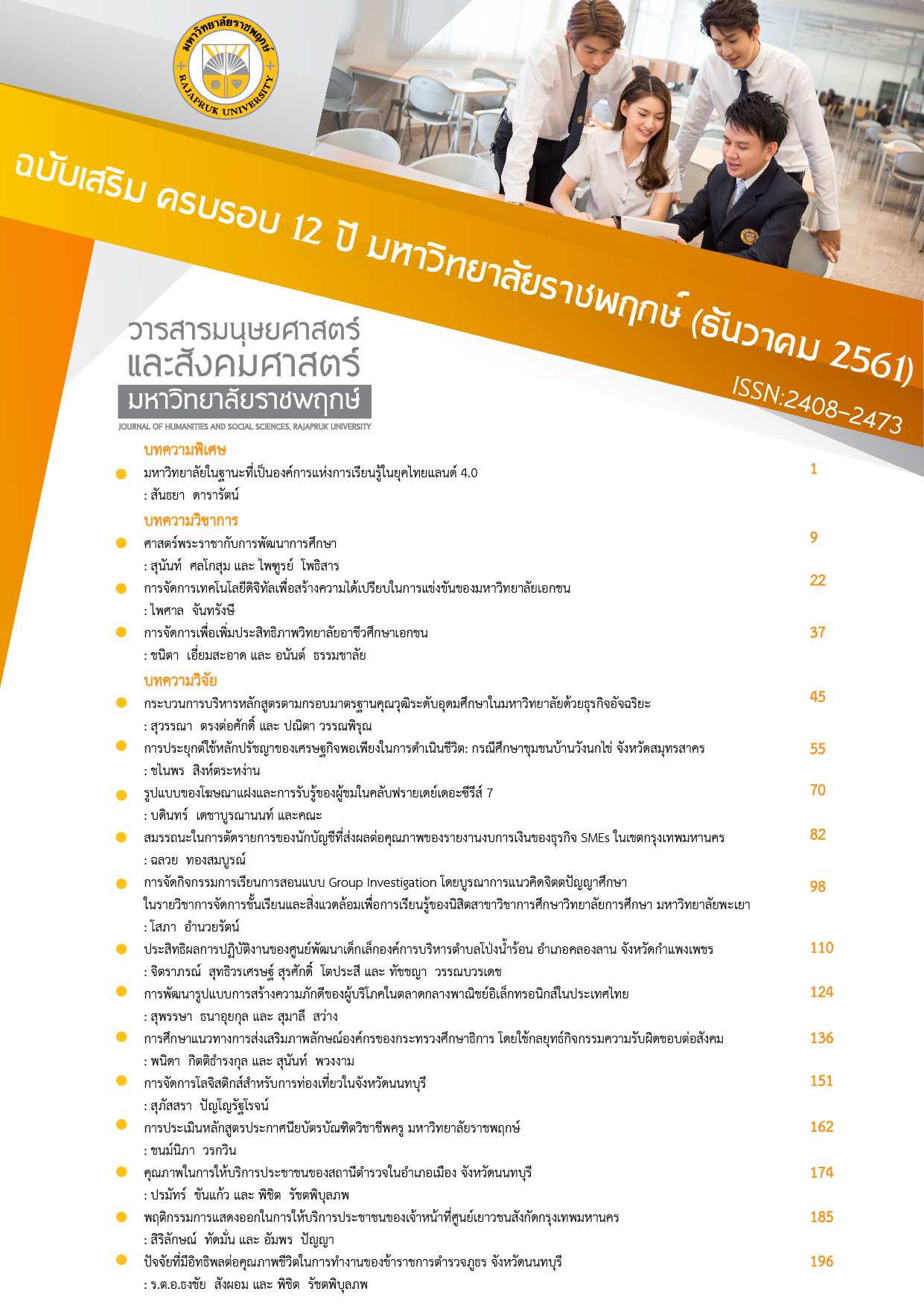การพัฒนารูปแบบการสร้างความภักดีของผู้บริโภคในตลาดกลางพาณิชย์อิเล็กทรอนิกส์ในประเทศไทย
##plugins.themes.bootstrap3.article.main##
摘要
การวิจัยครั้งนี้มีวัตถุประสงค์ 1) เพื่อศึกษาถึงความสัมพันธ์ระหว่างคุณภาพการให้บริการ ความไว้วางใจ ความพึงพอใจและการรับรู้คุณค่าของช่องทางออนไลน์ที่ผู้บริโภคได้รับมีอิทธิพลต่อความภักดีในการซื้อสินค้าและบริการต่อตลาดกลางพาณิชย์อิเล็กทรอนิกส์ในประเทศไทย 2) เพื่อศึกษาถึงปัจจัยที่สร้างความภักดีที่ทำให้ผู้บริโภคมาใช้บริการตลาดกลางพาณิชย์อิเล็กทรอนิกส์ในประเทศไทยสำหรับการซื้อสินค้าและบริการ 3) เพื่อพัฒนารูปการสร้างความภักดีของตลาดกลางพาณิชย์อิเล็กทรอนิกส์ในประเทศไทย การวิจัยนี้เป็นการวิจัยเชิงปริมาณ โดยใช้แบบสอบถามออนไลน์เป็นเครื่องมือในการเก็บรวบรวมข้อมูลจากผู้บริโภคที่เคยซื้อสินค้าผ่านตลาดกลางพาณิชย์อิเล็กทรอนิกส์ในประเทศไทย จำนวน 540 ชุด สถิติที่ใช้ในการวิเคราะห์ข้อมูล ได้แก่ ความถี่ ร้อยละ ค่าเฉลี่ย ส่วนเบี่ยงเบนมาตรฐาน และการวิเคราะห์สมการโครงสร้าง ผลการวิจัยพบว่า คุณภาพการให้บริการ ความไว้วางใจ ความพึงพอใจและการรับรู้คุณค่าของช่องทางออนไลน์ที่ผู้บริโภคได้รับมีความสัมพันธ์ต่อความภักดีในการซื้อสินค้าและบริการต่อตลาดกลางพาณิชย์อิเล็กทรอนิกส์ในประเทศไทยและคุณภาพการให้บริการมีอิทธิพลเชิงบวกต่อความไว้วางใจ คุณภาพการให้บริการมีอิทธิพลเชิงบวกต่อความพึงพอใจ คุณภาพการให้บริการมีอิทธิพลเชิงบวกต่อต่อการรับรู้คุณค่าของช่องทางออนไลน์ ความไว้วางใจมีอิทธิพลเชิงบวกต่อความพึงพอใจ ความพึงพอใจมีอิทธิพลเชิงบวกต่อการรับรู้คุณค่าของช่องทางออนไลน์ ความไว้วางใจมีอิทธิพลเชิงบวกต่อความภักดีต่อผู้บริโภค ความพึงพอใจมีอิทธิพลเชิงบวกต่อความภักดีต่อผู้บริโภคและการรับรู้คุณค่าของช่องทางออนไลน์มีอิทธิพลเชิงบวกต่อความภักดีของผู้บริโภค
##plugins.themes.bootstrap3.article.details##
参考
สุวัตถิ์ ไกรสกุล และ จุฑาภรณ์ คงรักษ์กวิน. (2558). ความพึงพอใจของประชาชนต่อการปฎิบัติของเจ้าหน้าที่ตามโครงการโรงพักเพื่อประชาชนของสถานีตำรวจภูธร บางศรีเมือง จังหวัดนนทบุรี. วารสารมนุษยศาสตร์และสังคมศาสตร์ มหาวิทยาลัยราชพฤกษ์. 1(1): 100 - 111
Aaker, D. A. (1991). Managung Brand Equity: Capitalizing on the Value of a Brand name. 2.
Balaji, M. S. (2009). Customer Satisfaction with Indian Mobile Services. IUP Journal of Management Research, 8(10): 52 - 62.
Belanche Gracia, D., Casaló Ariño, L. V., & Guinalíu Blasco, M. (2015). The Effect of Culture in Forming e-Loyalty Intentions: A Cross-Cultural Analysis Between Argentina and Spain. BRQ Business Research Quarterly, 18(4): 275 - 292. doi:10.1016/j.brq.2015.02.003
Bilgihan, A. (2016). Gen Y customer loyalty in online shopping: An integrated model of trust, user experience and branding. Computers in Human Behavior, 61, 103 - 113. doi:https://doi.org/10.1016/j.chb.2016.03.014
Carlson, J., O’Cass, A., & Ahrholdt, D. (2015). Assessing customers’ perceived value of the online channel of multichannel retailers: A two country examination. Journal of Retailing and Consumer Services, 27: 90 - 102.
Chiu, C.-M., Hsu, M.-H., Lai, H., & Chang, C.-M. (2012). Re-examining the influence of trust on online repeat purchase intention: The moderating role of habit and its antecedents. Decision Support Systems, 53(4): 835 - 845. doi:https:// doi.org/10.1016/j.dss.2012.05.021
Crosby, L. A., Evans, K. R., & Cowles, D. (1990). Relationship Quality in Services Selling: An Interpersonal Influence Perspective. Journal of Marketing, 54(3): 68 - 81. doi:https://doi.org/10.2307/1251817
Dick, A. S., & Basu, K. (1994). Customer Loyalty: Toward an Integrated Conceptual Framework. Journal of the academy of marketing science, 22(2): 99 - 113.
Kraisakul, S. & Kongrukkawin, J. (2015). Satisfaction of People towards Polices’ Duty Performance under the Police Station for People Project of Bangsrimuang Police Station Nonthaburi Province. Journal of Humanities and Social Sciences Rajapruk University, 1(1): 100 - 111. (in Thai)
Moriuchi, E., & Takahashi, I. (2016). Satisfaction trust and loyalty of repeat online consumer within the Japanese online supermarket trade. Australasian Marketing Journal (AMJ), 24(2): 146 - 156.
Oliver. (1999). Whence Consumer Loyalty?. Journal of Marketing, 63(33): 33 - 44.
Parasuraman, A., Zeithaml, V. A., & Malhotra, A. (2016). E-S-Qual. Journal of Service Research, 7(3): 213 - 233. doi:https://doi.org/10.1177/1094670504271156
Pham, T. S. H., & Ahammad, M. F. (2017). Antecedents and consequences of online customer satisfaction: A holistic process perspective. Technological Forecasting and Social Change, 124: 332 - 342. doi:https://doi.org/10.1016/ j.techfore. 2017.04.003
Sfenrianto, S., Wijaya, T., & Wang, G. (2018). Assessing the Buyer Trust and Satisfaction Factors in the E-Marketplace. Journal of theoretical and applied electronic commerce research, 13(2): 43 - 57.
Subramanian, N., Gunasekaran, A., Yu, J., Cheng, J., & Ning, K. (2014). Customer satisfaction and competitiveness in the Chinese E-retailing: Structural equation modeling (SEM) approach to identify the role of quality factors. Expert Systems with Applications, 41(1): 69 - 80.
Sullivan, Y. W., & Kim, D. J. (2018). Assessing the effects of consumers’ product evaluations and trust on repurchase intention in e-commerce environments. International Journal of Information Management, 39: 199 - 219. doi:https://doi.org/10.1016/j.ijinfomgt.2017.12.008
Wiratchai, N. (2548). Research Trends in Knowledge Social. Journal of Educational Administration, Khon Kaen University, 1(2): 9 - 18. (in Thai)
Zehir, C., & Narcıkara, E. (2016). E-Service Quality and E-Recovery Service Quality: Effects on Value Perceptions and Loyalty Intentions. Procedia - Social and Behavioral Sciences, 229: 427 - 443. doi:https://doi.org/10.1016/j.sbspro.2016. 07.153
Zeithaml , V. A. (1998). Consumer Perceptions of Price, Quality, and Value: A Means-End Model and Synthesis of Evidence. Journal of Marketing, 52(3): 2 - 22.

